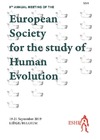Please use this identifier to cite or link to this item:
https://accedacris.ulpgc.es/handle/10553/57610
| Title: | Fire and short-term human occupations in Iberia during MIS 4: Evidence from Abric del Pastor (Alcoy, Spain) | Authors: | Mallol, Carolina Hernández, Cristo M. Mercier, Norbert Falguères, Christophe Arous, Eslem Ben Carrancho, Ángel Cabanes, Dan Connolly, Rory Vidal Matutano, Paloma Pérez, Leopoldo Fagoaga, Ana Marquina-Blasco, Rafael Ruíz-Sánchez, F.J. Mayor, Alejandro Galván, Bertila |
UNESCO Clasification: | 550405 Prehistoria 550501 Arqueología |
Issue Date: | 2019 | Abstract: | A relatively low amount of Middle Palaeolithic sites in Europe dating to MIS 4 and absence of anthropogenic fire in some of the sites brings to question the way in which this period of global cooling might have affected the Neanderthal population. The Iberian Peninsula is a key area to explore this issue, as it has been considered as a glacial refugium during critical periods of the Neanderthal time line and might therefore yield archaeological contexts in which we can explore possible changes in the behavior and settlement patterns among Neanderthal groups during MIS 4. Here we report recent data from Abric del Pastor, a small rockshelter in Alcoy (Alicante, Spain) with a stratified deposit containing Middle Palaeolithic remains. We present the results of our latest investigations at the site, which consist in: micromorphological data on site formation, absolute dates (optical stimulated luminescence and ESR/U-series) that frame the sequence within MIS4 and multi-proxy geoarchaeological evidence of in situ anthropogenic fire, including microscopic evidence of in situ combustion residues, wood ash and thermally altered sediment. We also present archaeostratigraphic evidence of recurrent, functionally diverse, short-term human occupation of the rock shelter that reveals similar settlement patterns to those documented in contexts from the following MIS 3 period. This data is complemented by a millennial scale record of past rainfall variability and local vegetation dynamics obtained through a multi-proxy paleoecological study in which we analysed sedimentary n-alkanes derived from leaf waxes, in addition to their associated carbon and hydrogen isotopic ratios (δ 13 C wax and δ 2 H wax ), as proxies for past vegetation and rainfall variability. This was coupled with bulk organic geochemistry (TOC, %N, %S), anthracology, microfauna and macrofauna analyses as additional proxies for selected sub-units through the sequence. Our results suggest that Neanderthals occupied the Central Mediterranean coast of the Iberian Peninsula during MIS 4. These Neanderthals had activity-specific sites, were not undergoing climatic stress and were habitual fire users. Comparable highresolution geoarchaeological data is needed for MIS 5 at a regional scale, as well as a geoarchaeological focus on the MIS 5/MIS 4 and MIS4/MIS 3 stratigraphic boundaries at different sites, which might conceal valuable paleoclimatic information and contribute to our understanding of associated human dynamics. | URI: | https://accedacris.ulpgc.es/handle/10553/57610 | Source: | "9th Annual meeting of the European Society for the Study of Human Evolution", University of Liège, 19-21 septiembre 2019 |
| Appears in Collections: | Póster de congreso |
Page view(s)
204
checked on Nov 9, 2024
Download(s)
179
checked on Nov 9, 2024
Google ScholarTM
Check
Share
Export metadata
Items in accedaCRIS are protected by copyright, with all rights reserved, unless otherwise indicated.
